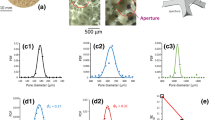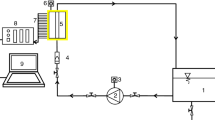Abstract
Pressure drop was measured across complex and simple structure metallic foams at different velocity ranges using air as working fluid. Darcian and non-Darcian permeability parameters, K and C, were determined by fitting experimental data with widely accepted quadratic model of Hazen-Dupuit-Darcy. Generally, the experimental results are in good agreement with the model. The differences in K and C values between the two types of metallic foams are due to the different microstructure. For the simple structure specimens, permeability K increased whereas non-Darcian permeability C decreased with increasing pore diameter. The effect of pore size on the permeability of complex structure metallic foams seems to be opposite to that observed with the simple structure specimens and to results reported by other researchers on other porous medium. This discrepancy mainly stems from the differences in window concentration in addition to some heterogeneity in the foam that impeded the gas flow on one side of the specimens. The difference in pressure drop observed in the different metallic foams is due to combined effect of K and C. However, for simple structure foams, K and C could be predicted by Ergun-like model using appropriate values for the empirical constants. The permeability K is significantly affected by pore size and porosity. The quadratic term of Hazen-Dupuit-Darcy equation is mainly due to the inertia of the flow and partially to the drag exerted by the microstructure of the metallic foam. For both foams, as the porosity increases, pressure drop decreases and permeability, K, increases. The introduction of the open cross sectional area term enabled better understanding of the permeability of metallic foams with intricate morphologies.



















Similar content being viewed by others
References
Lage JL (1998) In: Ingham BD, Pop I (eds) Transport phenomena in porous media. pp 1–30
Ward JC (1964) ASCE J Hydraulics Division 90(HY5):1
Beavers GS, Sparrow EM, Rodenz DE (1973) J Appl Mech 40(3):655
Antohe BV, Lage JL, Price DC, Weber RM (1997) J Fluids Eng 119(2):405
Davis PA, Olague NE, Goodrich MT (1992) Adv Water Resour 15:175
Boomsma K, Poulikakos D (2002) J Fluids Eng 124(1):263
Scheidegger AE (1974) The physics of flow through porous media. 3rd edn., University of Toronto Press, ISBN: 0-8020-1849-1
Diedericks GPJ, Du Plessis JP (1997) Math Eng Industry 6(3):133
Beckermann C, Viskanta R (1987) Int J Heat Mass Transfer 30(7):1547
Tadrist L, Miscevic M (2004) Exp Thermal Fluid Sci 28(2):193
Paek JW, Kang BH, Kim SY, Hyun JM (2000) Int J Thermophys 21(2):453
Innocentini DM, Salvini Vania (1999) Mater Res (Sao Carlos, Brazil) 2(4):283
Innocentini DM, Victor C (2001) J Am Ceramic Soc 84(5):941
Bhattacharya A, Mahajan RL (2002) Int J Heat Mass Transfer 45(5):1017
Du Plessis P (1994) Chem Eng Sci 49(21):3545
Fourie JG, Du Plessis P (2002) Chem Eng Sci 57(14):2781
Boomsma K, Poulikakos D, Ventikos Y (2003) Int J Heat Fluid Flow 24(6):825
Despois JF, Mortensen A (2005) Acta Materialia 53(5):1381
Fand RM, Kim BYK, Lam ACC, Phan RT (1987) ASME J Fluids Eng 109(3):268
Innocentini DM, Salvini VR, Pandolfelli VC, Coury JR (1999) Am Ceramic Soc Bull 78(9):78
Innocentini DM, Antunes WL, Baumgartner JB, Seville JPK, Coury JR (1999) Mater Sci Forum 299–300(5):19
Rumer RR, Drinker P (1966) J Hydraulic Div., Am Soc Civil Engineers 89(6):193
Banhart J, Baumeister J (1998) J Mater Sci 33(6):1431
ReceMat International, “RECEMAT® metal foam: extremely porous material”, https://doi.org/www.recemat.com/en/, on 28th December, 2005
Gauthier M, Lefebvre L, Thomas Y, Bureau M (2004) Mater Manufact Process 19(5):793
Dukhan N, Alvarez A, (2004) In: Proceedings of the 2004 ASME international mechanical engineering congress and exposition, Anaheim, California USA, November 13–20 pp 595–601
Acknowledgement
The authors gratefully acknowledge the financial support received from NSERC and NATEQ. The authors would also like to thank NRC-IMI, Boucherville, Quebec, Canada and RECEMAT International, Netherlands for providing the samples.
Author information
Authors and Affiliations
Corresponding author
Rights and permissions
About this article
Cite this article
Medraj, M., Baril, E., Loya, V. et al. The effect of microstructure on the permeability of metallic foams. J Mater Sci 42, 4372–4383 (2007). https://doi.org/10.1007/s10853-006-0602-x
Received:
Accepted:
Published:
Issue Date:
DOI: https://doi.org/10.1007/s10853-006-0602-x




